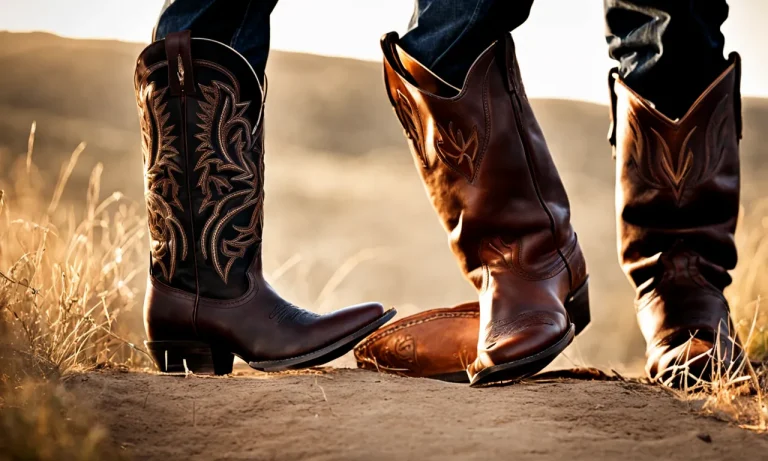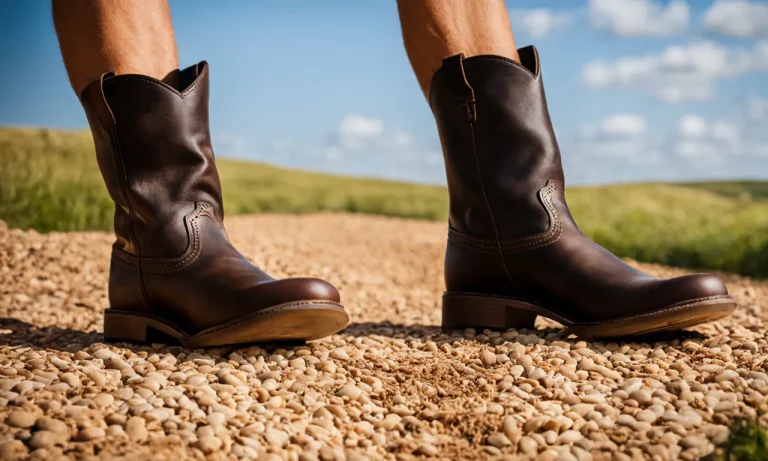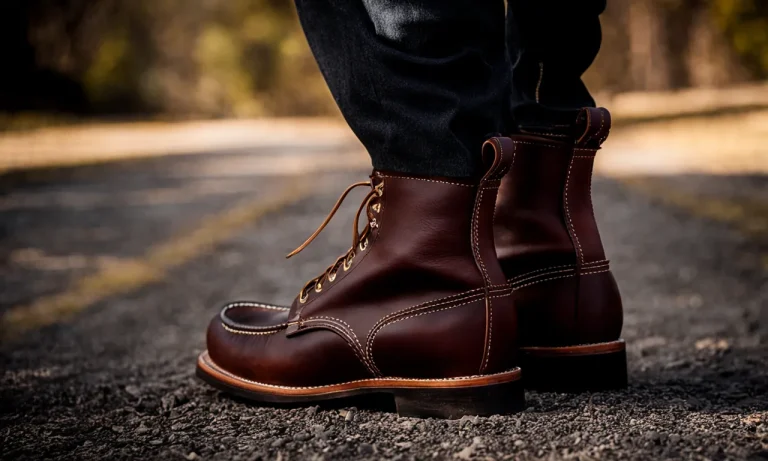Timberland boots are known for their rugged style and durability. However, over time the soles can wear down and need replacing. If you’re looking to breathe new life into your favorite pair of Timberlands, a sole replacement can restore traction and comfort.
If you’re short on time, here’s a quick answer to your question: The process of replacing Timberland boot soles involves removing the old sole with a knife, cleaning and preparing the boot, gluing on the new sole, and allowing time for the glue to cure before wearing them again.
In this comprehensive guide, we’ll walk through all the steps and tools you need to successfully replace the soles on your Timberland boots yourself.
Assess if Your Timberlands Need New Soles
Before replacing the soles on your Timberland boots, it’s important to assess whether they actually need to be replaced. Here are a few key indicators to look out for:
Inspect the tread depth
One of the easiest ways to determine if your Timberlands need new soles is to check the tread depth. The tread is the pattern on the bottom of the sole that provides traction. Over time, the tread can wear down, reducing the grip and traction of the boots.
To inspect the tread depth, hold the boot at eye level and compare it to a new pair. If the tread on your boots is significantly shallower, it may be time for a replacement.
Check for cracking or damage
Another sign that your Timberlands may need new soles is if you notice any cracking or damage. Inspect the soles carefully, paying attention to any visible cracks or splits. Additionally, look for any signs of excessive wear or damage that could affect the overall performance of the boots.
If you notice any significant issues, it’s best to replace the soles to ensure the longevity and functionality of your Timberlands.
Test traction on different surfaces
To further assess the condition of your Timberland boot soles, it’s a good idea to test the traction on different surfaces. Take your boots for a walk on various terrains like pavement, grass, or gravel.
Pay attention to how well the boots grip the ground and if you experience any slipping or sliding. If you notice a decrease in traction or stability, it may be a sign that the soles need to be replaced.
Remember, proper maintenance and timely replacement of soles are essential to keep your Timberland boots in top-notch condition. If you’re unsure about the state of your boots or need assistance with replacing the soles, don’t hesitate to consult a professional cobbler or visit the official Timberland website for guidance.
Purchase Replacement Soles
When it comes to replacing the soles on your Timberland boots, there are a few important factors to consider. The first step is to purchase the right replacement soles. Here are some tips to help you make the right choice:
Get the same sole type
Timberland offers a variety of sole types for their boots, such as Vibram, rubber, and leather soles. To maintain the original look and feel of your boots, it’s best to get the same type of sole as the original.
This will ensure that your boots not only look great but also provide the same level of comfort and durability.
Match size and tread pattern
When purchasing replacement soles, it’s crucial to match the size and tread pattern of your original soles. This will ensure a proper fit and prevent any discomfort or instability when wearing your boots.
Take accurate measurements of your current soles and compare them to the available options to find the closest match.
Consider durability of materials
The durability of the replacement soles is another important factor to consider. Look for soles made from high-quality materials that can withstand regular wear and tear. Additionally, consider the specific conditions in which you’ll be wearing your boots.
If you often encounter wet or slippery surfaces, opt for soles with excellent traction to ensure your safety.
It’s also worth noting that you can find replacement soles for Timberland boots from various sources, including authorized Timberland retailers, shoe repair shops, and online marketplaces. Take the time to research and compare options to find the best quality soles for your boots.
Tools and Supplies Needed
Replacing the soles on your Timberland boots is a rewarding project that can extend the life of your favorite footwear. Before you get started, make sure you have the following tools and supplies on hand:
Utility knife
A utility knife will come in handy when removing the old soles from your Timberland boots. Its sharp blade allows for precise cutting, making the process easier and more efficient. Remember to exercise caution when using a utility knife to avoid any accidents.
Sandpaper
Sandpaper is an essential tool for preparing the surface of the new soles and ensuring proper adhesion. By gently sanding the area where the old soles were removed, you create a rough texture that helps the contact cement glue adhere better.
Contact cement glue
Contact cement glue is the adhesive of choice when it comes to attaching new soles to your Timberland boots. It provides a strong bond that withstands wear and tear, ensuring the longevity of your repaired boots. Apply the glue evenly and allow it to dry according to the manufacturer’s instructions.
Q-tips
Q-tips are useful for applying contact cement glue to smaller, hard-to-reach areas of your boots. Their precise tips allow for controlled application, ensuring that the glue is evenly distributed and avoiding any messy excess.
Rags
Rags are handy for cleaning any excess glue or dirt from your boots during the repair process. Keep a few on hand to wipe away any spills or smudges, ensuring a neat and professional-looking repair.
Gloves
Wearing gloves is important when working with contact cement glue. This adhesive is strong and can be difficult to remove from your skin. Protect your hands by wearing gloves, and be sure to follow the safety instructions provided by the manufacturer.
Newspaper
Using newspaper as a protective surface is a smart idea to catch any drips or spills while working with contact cement glue. Lay down a layer of newspaper on your work area to keep it clean and avoid any damage to surrounding surfaces.
By gathering these tools and supplies, you’ll be well-prepared to replace the soles on your Timberland boots and restore them to their former glory. Remember to read and follow the manufacturer’s instructions for each product, and take your time to ensure a quality repair.
Step-by-Step Guide to Replace Soles
Remove old soles with utility knife
To begin the process of replacing the soles on your Timberland boots, you will need to carefully remove the old soles using a utility knife. Take your time and make sure to cut along the edges of the sole to avoid damaging the upper part of the boot.
Once the old soles have been removed, discard them and prepare for the next step.
Sand boot and new sole surfaces
After removing the old soles, it’s important to sand both the boot and the new sole surfaces. This step ensures that the glue will adhere properly and provides a clean and smooth surface for the new soles to be attached.
Use a fine-grit sandpaper to gently sand both surfaces, being careful not to apply too much pressure.
Clean surfaces with rag
Once the sanding is complete, use a clean rag to wipe away any dust or debris from both the boot and the new sole surfaces. This step is crucial as it ensures that there are no particles that could interfere with the bonding process.
Take your time and thoroughly clean both surfaces before moving on to the next step.
Apply contact cement glue
Now it’s time to apply the contact cement glue to both the boot and the new sole surfaces. This type of glue is commonly used for shoe repairs and provides a strong and durable bond. Follow the instructions on the glue’s packaging for the best results.
Apply an even layer of glue to both surfaces, making sure to cover the entire area that will be in contact with each other.
Let glue become tacky
After applying the glue, it’s important to let it become tacky before attaching the new soles. This usually takes about 10-15 minutes, but make sure to follow the instructions provided with the glue. The tackiness of the glue is what allows it to adhere properly and create a strong bond between the boot and the new soles.
Press soles onto boot firmly
Once the glue has become tacky, carefully align the new soles with the boot and press them firmly together. Apply even pressure across the entire surface to ensure a secure bond. It’s important to work quickly and accurately during this step, as the glue will start to set once the two surfaces are in contact.
Allow glue to fully cure
After pressing the soles onto the boot, it’s crucial to allow the glue to fully cure before wearing the boots. This process usually takes at least 24 hours, but it’s recommended to wait 48 hours to ensure the strongest bond possible.
Patience is key during this step, as wearing the boots too soon could compromise the integrity of the bond.
Trim excess sole material
Once the glue has fully cured, use a utility knife or scissors to trim any excess sole material that may be hanging over the edges of the boot. Take your time and make precise cuts to achieve a clean and professional finish.
This step will not only improve the appearance of the boots but also prevent any potential tripping hazards.
Frequently Asked Questions
How long does it take for the glue to cure?
The time it takes for the glue to cure can vary depending on the type of glue you use. Generally, most shoe repair glues require 24 to 48 hours to fully cure. It is important to follow the instructions provided by the glue manufacturer to ensure proper curing.
Rushing the process may result in the sole not adhering correctly and potentially coming off later.
Can I walk on the boots right after attaching the new soles?
It is not recommended to walk on the boots immediately after attaching the new soles. Give the glue enough time to fully cure and bond with the boot. Walking on the boots too soon may cause the soles to become loose or detach.
It is best to wait for the recommended curing time before putting weight on the boots and using them regularly again.
Is a sole replacement better than just gluing the old sole back on?
A sole replacement is generally considered a better option than just gluing the old sole back on. Gluing the old sole back on may provide a temporary fix, but it may not be as durable or long-lasting. With a sole replacement, you are replacing the entire sole, ensuring a stronger bond and better overall performance.
It also allows you to choose a new sole that suits your needs and preferences.
Should I take the boots to a cobbler instead?
While it is possible to replace the soles on Timberland boots yourself, taking them to a professional cobbler is a great option. Cobbler has the experience, tools, and expertise to ensure a proper sole replacement.
They can also provide guidance and advice on the best type of sole for your specific needs. If you are unsure or uncomfortable doing the replacement yourself, it is always recommended to seek professional help to ensure the best results.
Conclusion
With the right materials and a bit of handiwork, you can successfully replace the soles on your favorite Timberland boots. This restores traction and comfort so you can keep wearing them for seasons to come.
Just be patient during the process and allow plenty of time for the glue to fully cure before taking them out on rugged terrain again.






